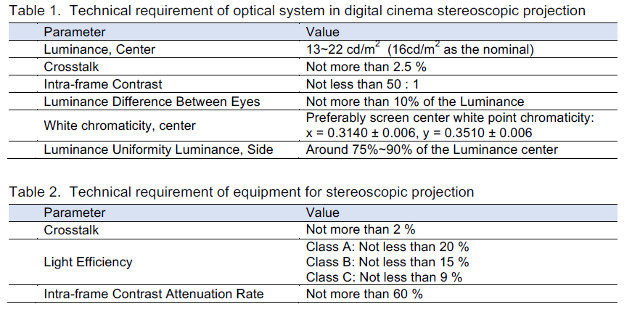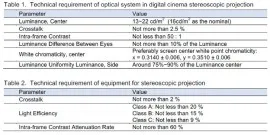One of the papers delivered at the SMPTE conference focused on what the Chinese government and exhibitors are doing about image quality – both 2D and 3D. There already exists a Chinese standard, GD/J047-2013, called “Technical Requirements and Methods of Measurement for Digital Cinema Stereoscopic Projection.” The talk, delivered by Bo Gong of the Test Institute of Film Technical Quality, SAPPRFT, discussed this standard, tests that have been done in theaters to assess image quality, and plans to update the standard.
The current specifications in this standard are shown in the tables below.

Gong noted that 98% of screens in China are digital and that of these, more than 80% are 3D, so having a focus on 3D image quality is critical as 3D movie production is increasing. But Chinese theaters have similar problems as elsewhere: low luminance, low contrast, unclear details, poor light efficiency and improper projector configuration.
Gong performed some limited tests on digital cinema equipment and theaters. He presented results from a fairly good cinema which contains seven theaters along with the results from a poor cinema also with seven theaters. Where these theaters performed poorly was in the luminance at the center of the screen, cross talk and intra-frame (ANSI-like) contrast.
In looking at all the theaters they tested, there was a huge range in on-screen luminance with only 30% meeting the optimal luminance target. Nearly all failed the intra-frame goal of 50:1 ranging from 29:1 (active 3D) to 32:1 (polarized 3D) to 34:1 (color wheel 3D). As a result, they want to define a new measurement term: Intra-frame contrast attenuation rate. This is done by measuring the intra-frame contrast in 2D and in 3D and comparing the results. The 3D value should be no less than 60% of the 2D value.
There were a number of reasons cited for the poor performance, but simply cleaning the optics made a big impact.

